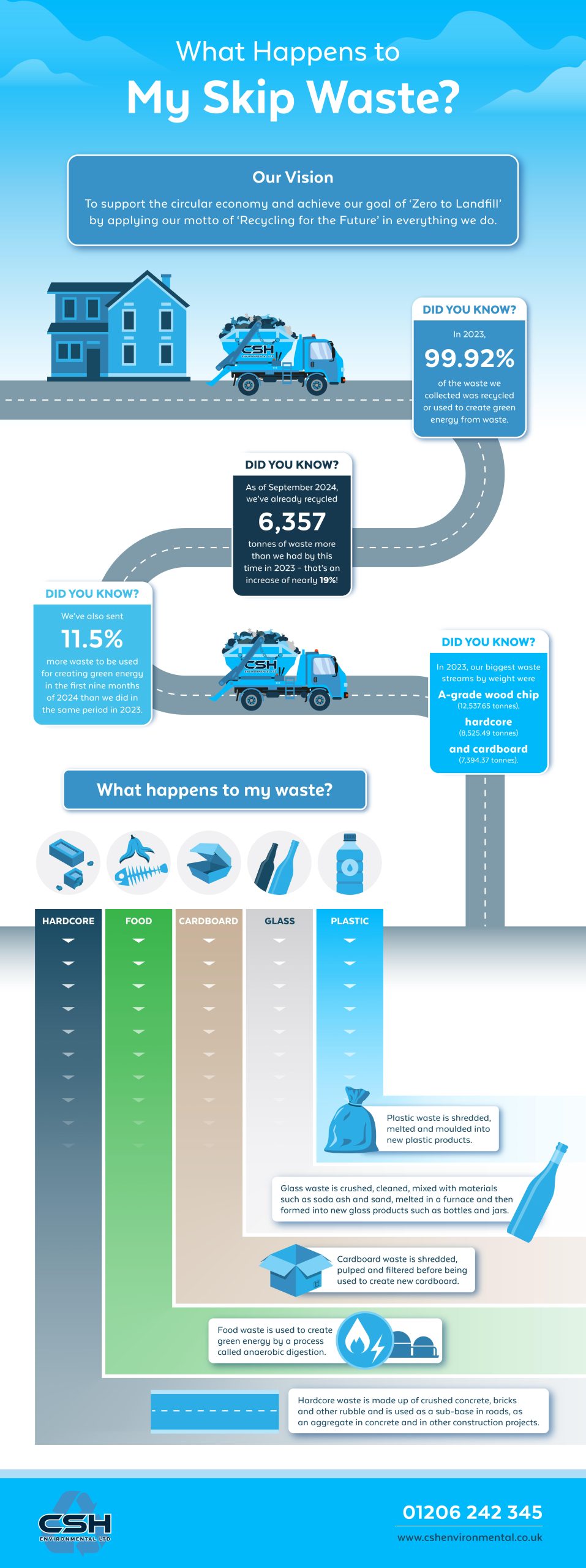What Happens To My Waste?
It used to be that once our customers had filled one of our skips with their waste, we collected it and took it away and they probably never gave the matter another thought.
But as more of us become more concerned with the effects of climate change and the increased burden that we place on the planet’s limited raw materials, that’s no longer the case. Now, more of our customers care about what happens to their waste afterwards.
That is often just the natural concern that many individuals have regarding the state of our environment, but it also matters to businesses that need to demonstrate both to their own customers and the government that they are meeting their environmental obligations.
So what does happen to it?

Recycling For The Future
Here at CSH Environmental, we’ve been upfront about our concern for how waste is managed for many years. Across this website, you’ll find numerous references to our motto – ’Recycling for the Future’ – together with our stated aim of achieving ‘Zero to Landfill’, the point at which all of the waste we collect is recycled.
To demonstrate that we want to be fully open about how we are doing with those policies and targets, each year we publish our waste figures, which tell you what happens to the different waste streams we collect.
The first thing that strikes when considering these figures is how consistent we’ve been. In 2016 – the first year for which we have figures – we recycled 99.84% of the waste we collected. By 2023, the last full year for which we currently have figures, we’d pulled that even closer to the magic 100% mark by recycling 99.92%.
However, it’s the levels of waste that we’re now handling that make this increase even more impressive. In 2016, 47,765 tonnes of waste passed through our hands compared to 82,931 in 2023 – that’s an increase of 73% in just seven years.
Read more about our commitment to recycling for the future and our Zero to Landfill target in our earlier blog.
What Happens To My Waste?
Different types of waste have different uses once they’ve been collected and separated. For instance, materials that are commonly recycled – such as paper, cardboard, glass and some plastics – are usually used to make more of the same, but without using up virgin resources.
Meanwhile, construction and demolition waste – such as crushed concrete, hardcore, bricks and rubble – can be reused in many new construction projects. This can include being used as a sub-base when building roads or as aggregate when making fresh concrete. This all means that fresh materials do not need to be dug out of the ground for these essential projects.
One area we’re increasingly involved in is helping to create green energy from food and liquid waste. In 2023, we sent over 2,720 tonnes of waste for this process, which uses a technique called anaerobic digestion to produce clean electricity, together with a byproduct called digestate that can be used as an environmentally-safe fertiliser.
With only the first nine months of waste figures for 2024 in at the time of writing, we’ve already exceeded that figure, with more than 2,990 tonnes of waste having gone for creating green energy.
All these examples demonstrate how CSH Environmental is supporting a circular economy with effective waste management.

When you team up with CSH Environmental for skip hire and to manage your waste, you’re not just getting a company that can put over 40 years’ worth of experience towards providing a reliable and cost-effective service. You’re also dealing with a business that puts its environmental responsibilities at the very heart of everything we do.
Do you want to know more? Then get in touch with us now for an initial chat about how we can help you and your business.
back to latest news